What Brain Research Does (and Doesn’t ) Tell Us About Learning
THERE IS LITTLE AGREEMENT about how
the human brain functions. In fact, says brain
researcher Michael Gazzaniga, “If we ever
learned how the brain learns to pick up a
pencil, it would represent a major achievement.”
Thus, while my role in Seattle Pacific
University’s Brain Center for Applied Learning
Research is to explore the connections
between brain science and the world of education,
there is a challenge. I reluctantly
believe that brain science has very little to
say at this time to the world of education.

(Click image to enlarge.)
|
 |
Given this perspective, is there any point
to a Brain Center for Applied Learning
Research? Although we don’t know much
about how the brain actually learns, I do
believe robust theoretical common ground
exists between the investigative brain sciences (especially the so-called cognitive
neurosciences) and the world of education
— as long as there is also room for a powerful
sense of boundaries.
Even if the brain data were mature, most
brain scientists have never taught 30 fourth
graders in a typical American classroom, half
of whose parents are getting a divorce, and
a quarter of whom are on some form of psychoactive
medication. Most educators do not
know how to run noninvasive imaging equipment,
or navigate their way through the subtleties
of brain development at the cellular
level. Yet, if we assume that education is at
its fundamentals about brain development,
these differing skill sets are hardly incompatible.
Rather, they are complementary — and,
from a research point of view, especially if
you are interested in end-use results, could
create a potent scientific force.
This, of course, suggests that brain professionals
and education professionals
conduct research together. And that is the
whole point of The Brain Center at SPU:
to describe a slice of biology where such
collaborative research projects might yield
prescriptive insights. Altogether, I have identified
12 such slices, which I sometimes
refer to as “brain rules.” These simply
denote basic things we know about the brain
that could form the nucleus of research projects,
which one day might be capable of
improving American education — if brain
scientists and education scientists choose
to integrate their worlds.
By John Medina
Director of the
Seattle Pacific
university Brain
Center for Applied
Learning Research
Back to the top
Back to Home |
